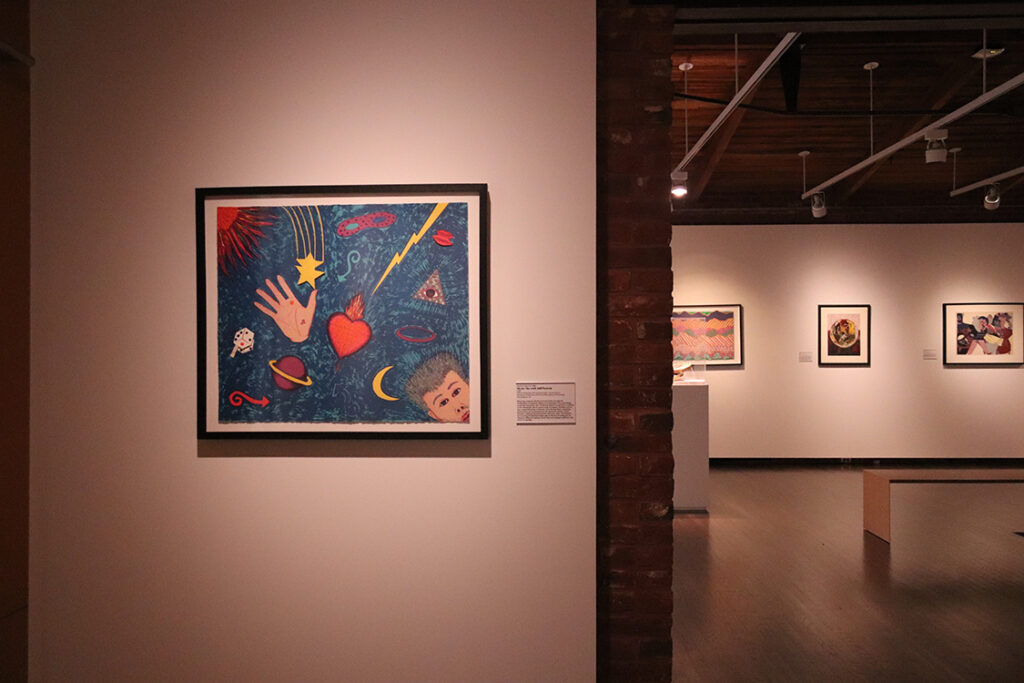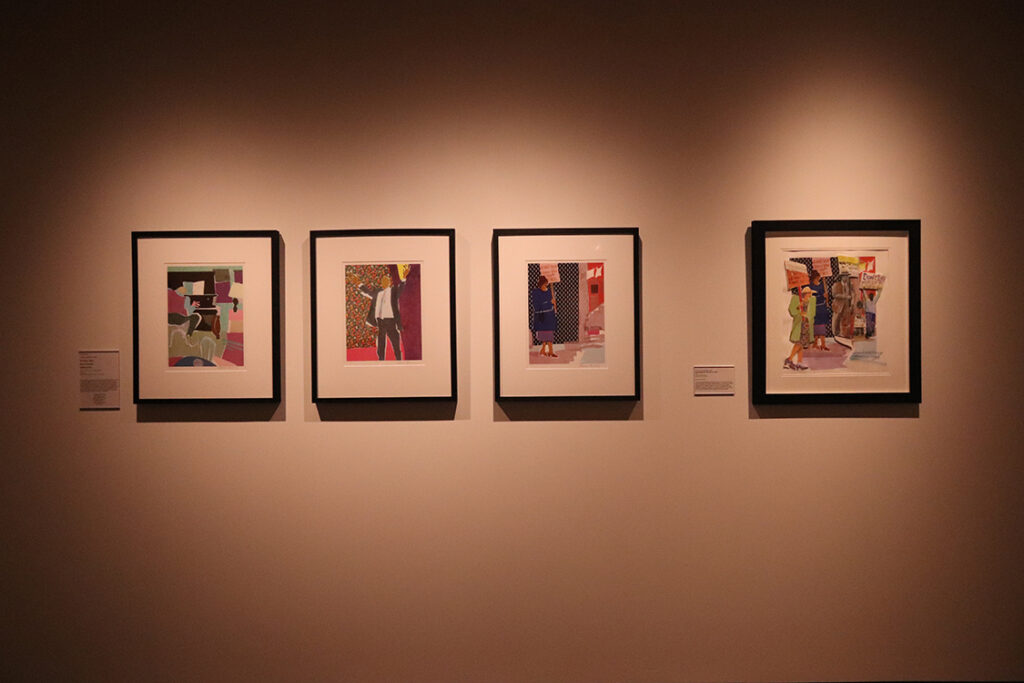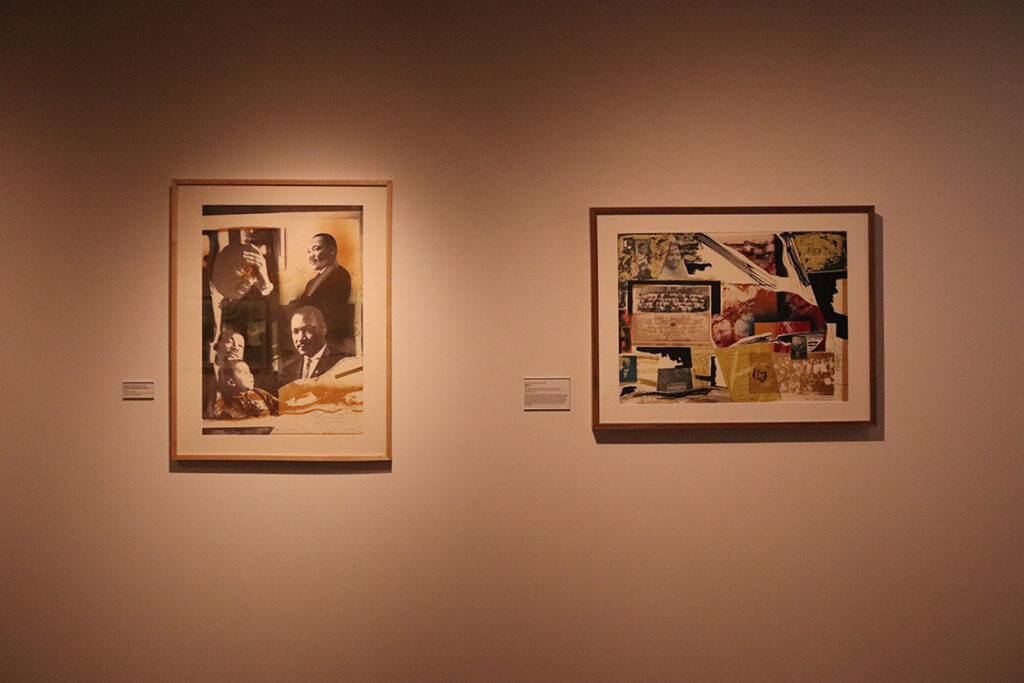





Printmaking and the Collage Aesthetic
Inspired by the visual complexity of the medium, many artists have embraced the aesthetic qualities of collage in other forms of art. A range of printmaking techniques enable artists to translate the effect of layering disparate materials or the appearance of cut or torn paper into their artwork. For artists who work primarily in the medium of collage, like Phoebe Beasley, printmaking is an outlet for further formal experimentation that also makes their work available to a broader audience.
Printmaking is often a collaborative practice that requires artists to work with master printers to achieve their aims. Many of the works in this gallery were produced at the Brandywine Workshop, an arts organization founded in Philadelphia in 1972 to encourage and support racial and cultural diversity in printmaking. With the support of resources at Brandywine, and other printmaking studios, these artists pushed the boundaries of the medium by adopting the visual strategies of collage.
26.
Betye Saar (b. 1926)
Mystic Sky with Self-Portrait
1989
Offset lithograph with printed paper constructions
Museums Collections, Gift of the Brandywine Workshop, Philadelphia, PA
Betye Saar explores identity and spirituality through the combination of disparate objects and materials in her assemblage sculptures and prints. Saar’s enduring interest in mysticism is evident in this lithograph with its cosmic array of imagery. Symbols such as dice, representing fate or fortune, and a flaming heart, signifying spiritual love, are scattered across her personal universe, which includes a self-portrait peering from the lower right. The shadows surrounding the floating images add an element of ambiguity by making it difficult to discern which items are collaged additions and which are printed.
27.
Pat Ward Williams (b. 1948)
Fly Girl Style
1994
Lithograph
Museums Collections, Gift of the Brandywine Workshop, Philadelphia, PA
Pat Ward Williams is known for her socially charged work examining the constructs of racial and gender identity. Working primarily as a photographer, Williams often incorporates found materials and text to create images with layered meanings. In Fly Girl Style, she explores the embodied experiences of women, using photographs of henna-decorated hands overlayed with smaller photographs of women with ornate hairstyles.
28.
from left to right
Phoebe Beasley (b. 1943)
The Weary Blues
Dream Variation
Mother to Son
From “Sunrise is Coming After While”
1998
Serigraph
Museums Collections, Gift of Paul R. Jones
Phoebe Beasley created these vibrant collage-style scenes for a book produced in collaboration with Dr. Maya Angelou. Titled Sunrise is Coming After While, the volume includes eight poems by celebrated poet Langston Hughes selected by Angelou and accompanied by Beasley’s illustrations, which were also released as an independent set of serigraphs. An accomplished collage artist, Beasley uses blocks of color and pattern to create a similar dynamic visual effect in her prints. Her illustrations respond to the musical cadence of Hughes’s words, as in this verse from his “Dream Variations”:
To fling my arms wide
In the face of the sun,
Dance! Whirl! Whirl!
Till the quick day is done.
Rest at pale evening …
A tall, slim tree …
Night coming tenderly
Black like me.
29.
Phoebe Beasley (b. 1943)
Reimagined, Mother to Son
2021
Collaged Monoprint
Museums Collections
Recent Acquisition
In 2021, Phoebe Beasley revisited the prints in her Sunrise is Coming After While series and added collage elements. The group of figures pasted onto Reimagined, Mother to Son transform the original serigraph into a crowded scene of activists. For Beasley, this new response to Langston Hughes’s 1922 poem reflects the importance of community members joining together to make change.
30.
Curlee Raven Holton (b. 1951)
Legacy
2007
Mixed media serigraph
Museums Collections, Gift of the artist in honor of Grandson Ché Alexander Holton
With Legacy, Curlee Raven Holton utilizes the visual strategies of collage to honor David Kearney McDonogh. Born an enslaved person in Louisiana, McDonogh became the first African American student to graduate from Lafayette College in Easton, Pennsylvania in 1844.
An accomplished printmaker and painter, Holton was a professor at Lafayette and in 1996 founded The Experimental Printmaking Institute, a professional printshop on campus. In the print, McDonogh’s life and legacy are framed within the broader history of the United States with collaged excerpts from the Voting Rights Act of 1965 and an early version of the Bill of Rights.
31.
Valerie Maynard (b. 1937)
Send the Message Clearly
1992
Offset lithograph
Museums Collections, Gift of the Brandywine Workshop, Philadelphia, PA
32.
Howardena Pindell (b. 1943)
Autobiography: Past and Present
1988/1989
Offset lithograph and serigraph
Museums Collections, Gift of the Brandywine Workshop, Philadelphia, PA
In her Autobiography series of mixed media works, Howardena Pindell brings together personal experience with found materials to produce new narratives. Pindell began the series in the aftermath of a traumatic car accident in which she suffered acute memory loss. In this print, she uses transparencies of postcards and photographs she had amassed before the accident to explore the process of deconstructing and reconstructing memory and identity. These fragmented images, which are dispersed around silhouettes of her body, reflect the influence of history, travel, and spirituality on Pindell’s life and artistic practice.
33.
Allan L. Edmunds (b. 1949)
MLK Community of Man
1990
Offset lithograph
Museums Collections, Gift of the Brandywine Workshop, Philadelphia, PA
34.
Allan L. Edmunds (b. 1949)
HFA V
2004
Lithograph with collage of photographs and halftones
Museums Collections, Gift of the Brandywine Workshop, Philadelphia, PA
Allen L. Edmunds, the founder of the influential printmaking center the Brandywine Workshop, uses the aesthetics of collage to enliven his prints of personal and historical subjects. In HFA V, Edmunds layers photographs from his own family archives and his mother’s handwritten notes with printed areas of color. The resulting print exemplifies his narrative style and use of varied mark-making techniques.

